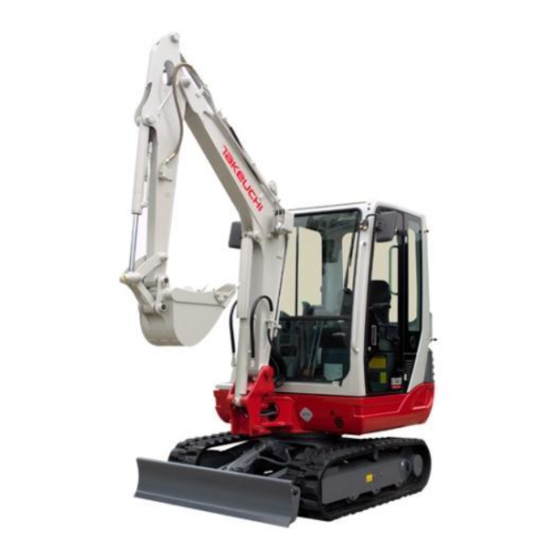
Advertisement
Advertisement
Table of Contents

Summarization of Contents
SAFETY ALERT SYMBOL
WARNING
Explains the safety alert symbol and its significance for hazard communication.
SIGNAL WORDS
DANGER
Indicates a high-risk hazard that, if not avoided, will result in death or serious injury.
WARNING
Indicates a medium-risk hazard that, if not avoided, could result in death or serious injury.
CAUTION
Indicates a low-risk hazard that, if not avoided, could result in minor moderate injury.
IMPORTANT
Alerts to situations that could cause damage to the machine or its components.
INTRODUCTION
FOREWORD
Provides general information about the manual's content and contact points for questions.
MANUAL STORAGE COMPARTMENT
Instructs on the location and proper use of the manual storage compartment on the machine.
SERIAL NUMBERS
Guides users on how to find and record the machine and engine serial numbers.
MACHINE DESCRIPTION
FRONT, REAR, LEFT AND RIGHT
Defines directional references for the machine from the operator's perspective.
DESIGNATED OPERATIONS
Lists the primary intended uses and applications for this mini excavator.
FEATURES
Highlights the key features and technological aspects of the machine.
BREAK-IN PERIOD
Details essential procedures for the initial 100-hour break-in to ensure longevity.
NOTES ON READING THIS MANUAL
Symbols used in this manual
Explains the meaning of various symbols used throughout the manual for enhanced understanding.
Transport
Loading and unloading
Provides instructions for safe loading and unloading operations of the excavator.
Hoisting the machine
Details the correct methods and precautions for hoisting the machine.
Securing the machine
Outlines the procedures for properly securing the machine during transport.
Precautions to be taken during transportation
Lists critical safety advice to be followed during the transportation of the equipment.
Maintenance
General
Introduction to the maintenance section and general principles.
Maintenance overview
Provides a summary of the maintenance schedule and recommended practices.
Cautions on maintenance
Highlights essential safety precautions to be observed during all maintenance activities.
Service data
Presents technical data, specifications, and parameters relevant to maintenance tasks.
Fuel and lubricant table
Lists the specified types and quantities of fuel and lubricants required for the machine.
Regularly replace the hydraulic oil
Emphasizes the importance and schedule for regular replacement of hydraulic oil.
List of consumables
A listing of consumable items necessary for performing routine maintenance.
List of tools
Specifies the recommended tools required for carrying out maintenance procedures.
List of tightening torques
Provides precise torque specifications for tightening various fasteners and components.
Safety-critical parts
Identifies parts essential for safety and their specific maintenance requirements.
Maintenance list
A comprehensive schedule of all maintenance tasks and their intervals.
Walk-around inspection
Details the procedure for a pre-operation walk-around inspection of the machine.
Daily inspection (every 10 hours)
Covers the essential daily checks to be performed for safe operation.
After the initial 50 hours (only for new machines)
Specific maintenance tasks required after the first 50 hours of operation for new equipment.
Troubleshooting
Symptoms that are not malfunctions
Helps distinguish normal operating characteristics from actual malfunctions.
If the engine overheats
Provides steps to identify and address engine overheating issues.
If the battery goes dead
Offers solutions for dealing with a depleted machine battery.
If a fuse blows
Instructions for locating, inspecting, and replacing blown fuses.
Inspecting and replacing the fuse
Detailed procedure for checking and replacing fuses in the electrical system.
Inspecting the fusible link
Guide on how to inspect the machine's fusible link for proper function.
Restarting after adding fuel
Steps to ensure a successful engine restart after refueling the machine.
Bleeding air from the fuel system
Procedure for removing air from the fuel system, especially after maintenance or refueling.
If a warning lamp flashes
Assists in understanding and responding to illuminated warning indicators on the dashboard.
Other symptoms
Covers a range of less common symptoms and their potential troubleshooting steps.
Lowering the boom to the ground
Emergency procedure for safely lowering the boom to the ground.
Towing
Provides critical instructions and safety precautions for towing the machine.
Specifications
Basic Specifications
Contains fundamental technical details and parameters of the machine.
Machine dimensions
Lists the physical dimensions, measurements, and size of the excavator.
Operating ranges
Defines the operational limits, capabilities, and working envelope of the machine.
Lifting Capacities
Provides crucial information on the safe load lifting capacities of the machine.
Options
General precautions
General safety advice to be followed when using optional equipment.
Safety precautions
Specific safety measures required for the installation and operation of attachments.
Cautions when installing attachments
Important safety warnings and guidelines for installing optional attachments.
Cautions when operating attachments
Key safety advice for operating the machine with various attachments fitted.
Attachment combination table
A reference table detailing compatible machine and attachment combinations.
Hydraulic breaker
Details the hydraulic breaker attachment, including operation and safety.
Cautions on operating
General operational cautions applicable when using the machine with attachments.
Replacing the hydraulic oil regularly
Guidance on the importance and frequency of hydraulic oil replacement, potentially for attachments.
Load safety device
Explains the function and operation of the machine's load safety device.
Emergency shut-off valve
Information on the emergency shut-off valve and its purpose in safety.
Overload warning device
Details the overload warning system and how it alerts the operator.
Accumulator
Provides information about the accumulator component and its operational role.
Operating the machine with an accumulator
Instructions for operating the machine when an accumulator is installed.
Battery switch
Information on the battery switch, its location, and function.
Selecting a lever pattern
Guidance on choosing and setting the preferred control lever operation pattern.
Switching the lever pattern
Instructions on how to change between different control lever pattern configurations.
Travel alarm
Information regarding the travel alarm system and its role in safety.















Need help?
Do you have a question about the TB235 and is the answer not in the manual?
Questions and answers